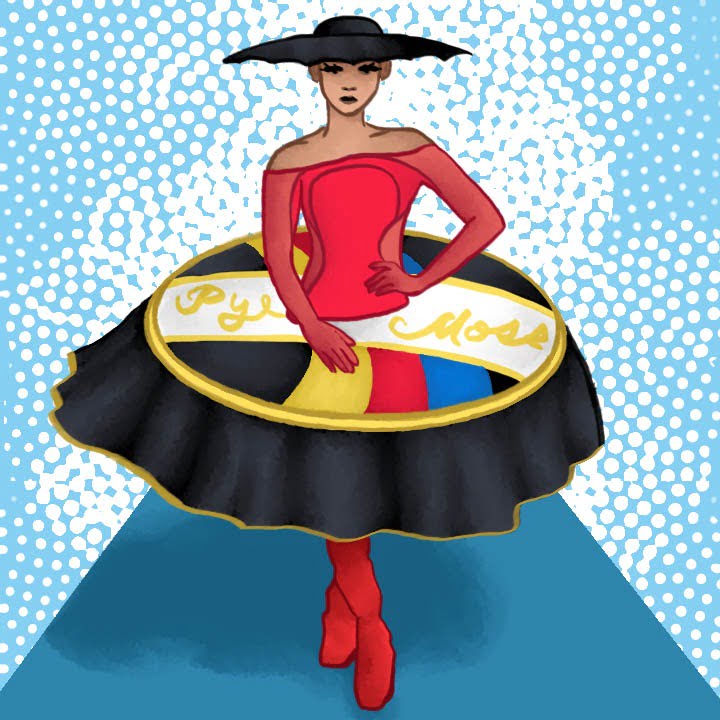Pyer Moss First Couture Show WAT U IZ: Historic Tribute To Black Inventors
By: Kai Yeo
“We are an invention inside of an invention. Inside of the creation of race, we made blackness. Uprooted from home and put in a foreign land, we made culture. And when they tried to strip our humanity, we made freedom so tethered to each other that it still shapes the world today.” – Pyer Moss show notes.
Kerby-Jean Raymond’s Pyer Moss label has unveiled his first-ever couture collection. The award-winning designer and creative director is the first Black American designer to be invited to present during Haute Couture Week, a historical achievement made even more successful by making his collection a tribute to Black inventors. All Pyer Moss shows attract interest, but this show had more buzz because of his exclusive invite by France’s Chambre Syndicale to show a collection, with officials in Paris extending the length of Couture Week to accommodate the rescheduled show due to Hurricane Elsa.
The Pyer Moss Couture 1 couture show, WAT U IZ, was opened by the last surviving member of Black Panther leadership and civil rights champion Elaine Brown. The setting was deeply significant: Villa Lewaro, an early 20th century mansion in Irvington, NY, built by Madam CJ Walker. Madam CJ Walker was American’s first self-made female millionaire and her estate served as a gathering place for leaders of the renaissance (her story is also on Netflix). Now, Elaine Brown’s words herald another landmark moment for black culture while celebrating the Black Panther’s 55th Anniversary.
The 28,000-square-foot estate, designed by Vertner Woodson Tandy (the first licensed black architect in New York State, and one of the seven founders of Alpha Phi Alpha fraternity at Cornell University), was recently purchased by the New Voices Foundation for an undisclosed amount. The foundation is the nonprofit branch of the New Voices Fund, a $100 million investment fund dedicated to entrepreneurs following in Walker’s footsteps. Both the fund and the foundation were created by Richelieu Dennis, who was seated at the front row at Pyer Moss.
“Where do we go from here? Where does the freedom movement go from here?” activist Elaine Brown opens the show quoting Dr. Martin Luther King Jr., but she also seemed to be reflecting on the history being made at the very moment. Jean Raymond, whose shows always entwine his ideas about fashion with those about culture, race, and society, said in an interview that his goal was “to highlight inventions by Black people and show them in a non-traditional way,” involving 3D construction and sculpture.
And so, there was the peanut butter dress, literally a huge, soft sculpted jar honoring George Washington Carver. The stunning roller cape that took two weeks to create, featuring hot rollers from head to toe. Each one wound round and round with strands of fake hair. An air-conditioning unit, a kitchen mop, an old-fashioned mobile phone he remembers his father carrying, a childhood ice cream cone. There was a pastel pink lampshade dress with beaded fringes, a metal folding chair, every single costume a sophisticated work of culture. And there was a refrigerator with magnets that spelled out, “But who invented Black trauma?” Each soft sculpture in the Pyer Moss couture show correlated to an invention on a list that designer Jean-Raymond had seen at the Library of Congress attributed to a Black individual. All the inventions Jean-Raymond chose from to celebrate spoke to his lived experiences, a beautiful show reminiscent of a masquerade ball or art installation.
Jean Raymond talks about paying homage to his Black culture, “I want people to experience Black wealth in not a dirty thing. It is one of several means to an end – this house, inventions, creativity, ingenuity, all of those things are pathways to that sort of economic independence. I’ve said a lot of things at my shows. I’ve talked about mental health, multiple prong approaches to liberation, and this is just one of them.” Richelieu Dennis will help oversee the transition of restoring the villa and making it an incubator and center for Black women artists and women-run businesses. Just as once upon a time the villa was a center for the artists and intellectuals of the Harlem Renaissance, the sculptured garments of Pyer Moss will eventually be part of an exhibit inside Villa Lewaro.
Watch the replay of Pyer Moss Couture 1 here.






